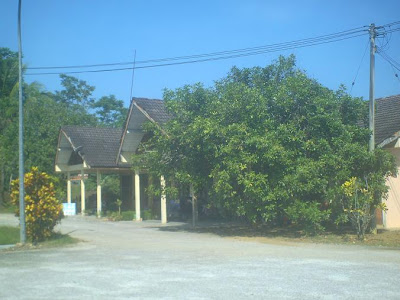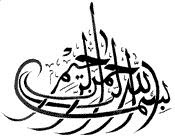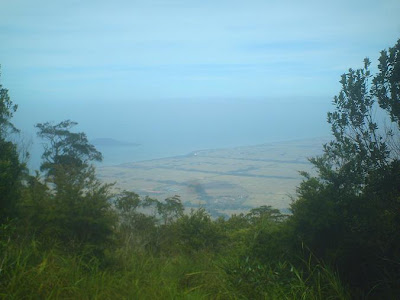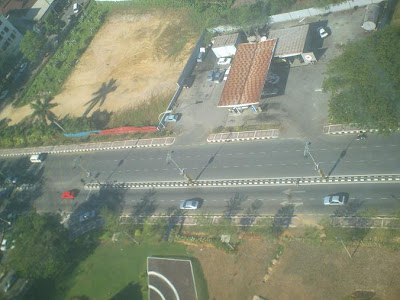Greetings all. The posting
The main players of the Perak-British war as depicted at the fort of Ngah Ibrahim... made in the wee hours last night happened to be my 162th posting. I should have thrown in the towel then as I was too tired after making a few other postings in my other blogspots throughout the day. But somehow I didn't feel so comfortable with that number. So let this be the 163th posting to set my mind at ease ya. As for the subject, I happened to have this set of pictures which needs to be featured right after that on Taiping and the fort of Ngah Ibrahim has been shown in all my three blogspots.
 The main door to the royal mausoleum. Now read back the posting The main players of the Perak-British war as depicted at the fort of Ngah Ibrahim... and you will notice that Laksamana Raja Mahkota Muhammad Amin was not listed as a major player there. Instead even in history books, his name is mentioned in passing as one of the signatories of the Pangkor Treaty of 1874. Apart from that, history only knows him as one of 3 main nobles exiled together with Sultan Abdullah to the Seychelles in Africa 1877. This happened after they were implicated for the murder of British first Resident to Perak, J.W.W. Birch in 1875...
The main door to the royal mausoleum. Now read back the posting The main players of the Perak-British war as depicted at the fort of Ngah Ibrahim... and you will notice that Laksamana Raja Mahkota Muhammad Amin was not listed as a major player there. Instead even in history books, his name is mentioned in passing as one of the signatories of the Pangkor Treaty of 1874. Apart from that, history only knows him as one of 3 main nobles exiled together with Sultan Abdullah to the Seychelles in Africa 1877. This happened after they were implicated for the murder of British first Resident to Perak, J.W.W. Birch in 1875...
 Here is the latest picture of Muhammad Amin's tomb. I'm very happy to see this as in my last visit (not counting the one made before going to Kedah some 4 days before), I think at least 3 months ago, there was no such building... The tomb was still a bunch of red earth marked by a pair of wood for gravestones! That despite the fact that the body was reburried here more than a year before, that is on 9th September 2006...
Here is the latest picture of Muhammad Amin's tomb. I'm very happy to see this as in my last visit (not counting the one made before going to Kedah some 4 days before), I think at least 3 months ago, there was no such building... The tomb was still a bunch of red earth marked by a pair of wood for gravestones! That despite the fact that the body was reburried here more than a year before, that is on 9th September 2006...
 The funny thing is I don't see his name engraved in any part of the tomb building... Apart from the Arabic letters for Amin which does sound like his name but is actually just an utterance after one is finished reading a verse of the Quran... The same like when a Christian says "Amen!"
The funny thing is I don't see his name engraved in any part of the tomb building... Apart from the Arabic letters for Amin which does sound like his name but is actually just an utterance after one is finished reading a verse of the Quran... The same like when a Christian says "Amen!"
 Even the head gravestone has no inscriptions... Normally this is where one puts the name and date of death of the deceased. Never mind that... Maybe the authorities will put the inscriptions later. I'm just happy to see my great great grandfather's tomb looking good and well built.
Even the head gravestone has no inscriptions... Normally this is where one puts the name and date of death of the deceased. Never mind that... Maybe the authorities will put the inscriptions later. I'm just happy to see my great great grandfather's tomb looking good and well built.
Hmm... Somehow suddenly I feel like putting a bit of my genealogy here at the risk of others accusing me of showing off... Perhaps, it is showing off. Perhaps it would get some out of touch kith and kins to try to mend back the family ties. Perhaps... Anyway, my name is Mohd Fahrulradzi bin (son of) Mohamad Sapiee bin Muhammad Arshad bin Muhammad Ali Wahi bin Muhammad Arshad bin Muhammad Amin (the deceased buried here)... Mohd is an official short-form for Muhammad while Mohamad is one of the modern-spelling.
Why did I suddenly feel like doing this? Well, I like to give justice to my great grandfather... One, because his role in leading the Perak Malays in the fight against the British were understated, even undermined in the history books. Second because his ties with the royalty is obscured such that some wonder why is he buried at Perak's royal mausoleum when he has no Raja (a princely title) to his name... Why wasn't he buried in Teluk Intan where there's a private cemetery reserved for the Laksamana family?

This is the tomb of the Sultan Abdullah who was exiled to Seychelles. Later, he, Laksamana Raja Mahkota Muhammad Amin, the much more well-known Ngah Ibrahim who carries the title Menteri Paduka Tuan (a minister) and Shahbandar (something like the royal harbour master) Uda Ma'amor who was also exiled there were brought to Singapore to be observed at all times by the British authorities centred there.
Sultan Abdullah however was "pardoned" and returned to Perak where he died in the 1920s and was buried here. The rest had to stay in Singapore where they died... That is until the remains of Muhammad Amin and Ngah Ibrahim was brought back in a grand ceremony, Ngah Ibrahim's remains reburied at his fort in Matang, Muhammad Amin's here...
Too bad, they couldn't find the tomb of Uda Ma'amor in Singapore. My condolences for the family. May he too rest in peace...
 This is the tomb of Raja Chulan, son of Sultan Abdullah just beside his father's grave. If I'm not mistaken, among Sultan Abdullah's children and descendants, he was the last (and only one I think) to get anywhere close to the throne following Perak's unique row of succession. Luckily, his name is immortalised as Jalan Raja Chulan in Kuala Lumpur's bustling Golden Triangle...
This is the tomb of Raja Chulan, son of Sultan Abdullah just beside his father's grave. If I'm not mistaken, among Sultan Abdullah's children and descendants, he was the last (and only one I think) to get anywhere close to the throne following Perak's unique row of succession. Luckily, his name is immortalised as Jalan Raja Chulan in Kuala Lumpur's bustling Golden Triangle...
Again, if I remember correctly, he died in 1933 bearing the title Raja di Hilir, 3rd in line from the throne behind the Raja Muda (or regent) and Raja Bendahara (2nd in-line but the title was later abolished)... And as far as I know, after that there's no one from Sultan Abdullah's clan standing in the list of succesion anymore...
Currently the positions are filled with descendants of Sultan Abdullah's first cousin Sultan Idris (the one who opened Bukit Chandan in the 1880s) . Only one position, that of Raja di Hilir (now 2nd in-line) is held by another, that is Raja Jaafar who is a descendant of Sultan Abdullah's younger brother, Raja Muda Musa...
OK... Back to the case of Laksamana Raja Mahkota Muhammad Amin. What is his relationship to royalty? The official genealogy put him as a third cousin of Sultan Abdullah as the Sultan's mother Wan Mahtra and Muhammad Amin's father Alang Wakap are second cousins. But this does not make one a royalty... Just like if a king married your sister. It doesn't make you royalty, it just makes you an in-law of a royalty. So why is Muhammad Amin buried at the royal mausoleum?
 The tomb of another member of the Perak royal family... But let's continue with the story of Muhammad Amin first...
The tomb of another member of the Perak royal family... But let's continue with the story of Muhammad Amin first...
And so the official story given on why Laksamana Raja Mahkota Muhammad Amin was admitted to the royal sanctum sanctorium was because he was granted the privilege by the current Sultan of Perak, Sultan Azlan Shah. Yes, the Sultan does have the power to do that. And so it was explained, Muhammad Amin was an honoured "commoner" who was granted a burial place among the Sultan Abdullah clan because of his loyalty to the former... The story goes that he was so loyal, he actually chose to be exiled to Seychelles along although he was never really implicated in the murder of J.W.W. Birch!
Now there is a story saying he was the actual mastermind behind that move to fight and chase out the British... It is said even the famous Datuk Maharajalela (something like the grand chamberlain) was subservient to him although official history rated the Datuk as the most celebrated figure in the death of Birch and the fight against the British!
Still, Muhammad Amin's influence and role were hugely underated. Instead another most celebrated figure is Ngah Ibrahim who happens to be Muhammad Amin's son in law! In fact some parties work very hard to put Ngah Ibrahim's name and prominence above all the others, even the Sultan. The tagline is this: Ngah Ibrahim amassed so much riches from tin mining in Larut that he became richer that the Sultan itself! Thus he is the spanking example of a Malay corporate figure, they said... A high symbol of success that should be emulated by all.
Well, that might as well be the case... The people who wants to promote his riches so much like to also point to the fact that Ngah Ibrahim paid for the Sultan's debt to the British or something. Oh the Sultan then was someone else, I couldn't remember who exactly. This might be something to be proud of for a lot of people but to me it isn't... I respect chivalry and nobility (in the true sense of the word) more than wealth... Besides, wasn't Ngah Ibrahim's penchant for wealth was what brought the Chinese miners by the droves? And this later created trouble which allowed the British to make active interference in Perak Malay affairs...
No, I don't respect Ngah Ibrahim's wealth at all. Frankly, I felt a slight distaste when the return of the remains of Ngah Ibrahim was harped so loudly everywhere that it looks like certain parties (again) tried to undermine Laksamana Raja Mahkota Muhammad Amin's return alongside. Come on... Face it man... Even the navy vessel carrying both the remains is of the name KD Laksamana Muhammad Amin... And face it again, it was Muhammad Amin who was buried at the royal mausoleum...
 The gravestone of the tomb shown in the previous picture revealed the person buried as Raja Muda Musa bin Sultan Jaafar. He is the younger brother of Sultan Abdullah...
The gravestone of the tomb shown in the previous picture revealed the person buried as Raja Muda Musa bin Sultan Jaafar. He is the younger brother of Sultan Abdullah...
Back to what royal rights does Muhammad Amin have to be buried here. OK, this is the hush, hush part... According to certain people, Muhammad Amin is actually a first cousin to Sultan Abdullah on the staff side... What does that mean? It means, Muhammad Amin's father and Sultan' Abdullah father were actually brothers! It further means, they both have the same royal grandfather! So why is this not shown in the official genealogy? This is why the hush, hush...
Sometimes a person has a certain name but later used a different official name after ascending the throne. So people who does not know better might mistake him as two different persons... This is the juncture where parties with vested interest could actually separate a whole family genealogy making it looks like two separate ones with little common link.
Now why one earth would one want to do that? Well for one, it could turn a royal into a commoner... For example by separating the identity of a person named Alang Muhammad who is also known as Raja Ahmad into two, you can create two separate genealogies with one showing the descendants of Alang Muhammad as commoners, another showing the descendants of Raja Ahmad as royalty... And to what end does this serve? For one, to stop the descendants of Alang Muhammad from a making a claim to the throne! Get it?
 Here is the area for the burial of Raja Muda Musa bin (or ibni which also means bin but sounds more royal) Sultan Jaafar and his clan... Among those buried here is the last person from Teluk Intan to be made a ruler in the last 120 plus years, Sultan Abdul Aziz, the 31st Sultan of Perak, son of Raja Muda Musa. Also in that area is another Raja Muda Musa, the son of Sultan Abdul Aziz! Not just they have the same names, this person and his grandfather both died while bearing the title Raja Muda, just a step away from becoming the ruler!
Here is the area for the burial of Raja Muda Musa bin (or ibni which also means bin but sounds more royal) Sultan Jaafar and his clan... Among those buried here is the last person from Teluk Intan to be made a ruler in the last 120 plus years, Sultan Abdul Aziz, the 31st Sultan of Perak, son of Raja Muda Musa. Also in that area is another Raja Muda Musa, the son of Sultan Abdul Aziz! Not just they have the same names, this person and his grandfather both died while bearing the title Raja Muda, just a step away from becoming the ruler!
Now, my relatives told me, we had a certain great grandmother who was known simply as Hajah Halijah, said to be very famous for her astounding beauty. Her beauty made princes go to war but eventually he married my grandfather's grandfather Laksamana Raja Mahkota Muhammad Arshad bin Muhammad Amin...
They said Hajah Halijah's father is Haji Musa... For information, the title Haji and Hajah are given to Muslims who have completed their hajj, pilgrimage to Mekah. But some said in hush hush voice that the father was actually Raja Muda Musa! That should explain why Hajah Halijah had her own entourage of dayangs (lady-in-waiting)... So why drop the name Raja? Wouldn't it be to her disadvantage as most people love to have grand titles, what more if its royal!
My grandmother used to say our family dropped the title because they don't want to be proud. Besides, the times have favoured family members who were ready to cooperate with the colonising British, the kind of cooperation which compromised the well-being and confidence of the Malays in general. So some family members where disappointed with the situation, so much so that they throw out the title Raja to stop themselves from being associated with royalty!
Hmm... I think that's all ya... Despite what other's might say, I think I have vindicated my great-great-great grandfather Laksamana Raja Mahkota enough (now I realise, I have to used the word great 3 times as I'm a 5th generation descendant).
Ah... Something more to be let out before I can truly call in a day (it's already past 2 am at this juncture!). For those who still dispute his royal status, look again at the title Laksamana Raja Mahkota... Why not just Laksamana like that used by the legendary Hang Tuah during the heydays of the Melaka empire? And no, it is not like the title Sri Wak Raja or such where the word Raja can be used for a nobleman who is not of royal birth...
In order to understand that, you have to turn the clock back almost 300 years ago when Sultan Muzaffar Shah III was the 13th ruler of Perak. He had a bodyguard (and Perak's top religious man) too by the name of Daeng Selili, a Bugis prince who is also his brother-in-law. In 1743 if I remember correctly, Daeng Selili was assigned to defeat some pirates at the waters of Pulau Sembilan at the mouth of the Perak river. He managed to defeat most and was about to have a face-off with the head honcho when it turned out, the head pirate was none other than his own brother, Daeng Hanasah!
Now, as why Daeng Hanasah became a pirate, I won't go into lengths... But I do understand he was actually supposed to be the next ruler in another country (not in Bugis land ya) when certain parties intervened. And thus he decided to become a pirate who mainly attack Western ships... Daeng Selili took his brother to meet Sultan Muzaffar. The brother was recognised as a fitting royalty and thus was made a Laksamana (admiral) guarding the waters of Perak... With the extra title Raja Mahkota (literally translated as the crown prince) which should sufficiently explain his true status.
For the record, Daeng Hanasah is my great-great grandfather who started the whole Laksamana Raja Mahkota lineage. His brother Daeng Selili got the title Datuk Maharajalela and it was inherited by his descendants...
Certain parties said what happened in Perak then was that some princes were driven out from their homelands and landed in Perak where they tried to set up a new kingdom. But Perak already had its own ruler and that lead to war. In order to make peace, they set up an agreement... As they are all of royal blood and a study of genealogy revealed they are after all related several generations up till down as Malay royalty often inter-marry... Furthermore the ties were further cemented when their children marry each other.
And so here's the deal... Let's create a rotational system... Once the current Sultan (said mainly from the old Melaka kingdom blood) is deceased, then let a family member of one prince (from Acehnese blood) get on the throne. Then it is one from the family of the Bugis blood... And so on, Melaka, Aceh, Bugis... Melaka, Aceh, Bugis...
Meanwhile, let them carry their respective titles Laksamana Raja Mahkota or Datuk Maharajalela or whatever the Melaka side chose to name their princes. Once up there, they are simply known as a Sultan from only one Perak compounded lineage...
And so they say, this is how the order of succesion was actually created. A tweak here and there with the genealogical charts (where a son-in-law or adopted son could actually be recorded as the son of a ruler!) should show a very smooth order of change, except in certain outstanding cases normally involving disputes... It's just that at later times especially after the British intervened, this story was shut out in order to cut out certain families from the deal while keeping the monopoly of ruling the country to certain branches only...
Enough! Now I can go to sleep... Cheers! :]

 Among the houses for staff there. Syahir stays in one of the houses with a wife and kid. I had a few deja vu here, at least twice, once inside the house, once outside...
Among the houses for staff there. Syahir stays in one of the houses with a wife and kid. I had a few deja vu here, at least twice, once inside the house, once outside...







































































